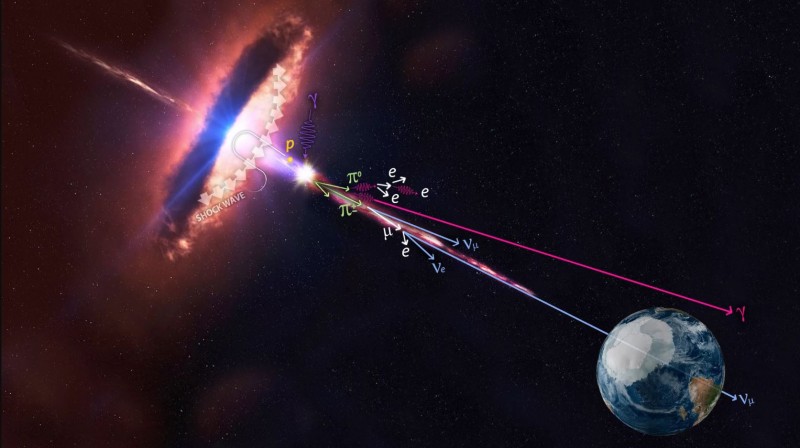Cosmic rays travel to Earth at relativistic speeds from deep space, but their origins have puzzled astronomers for over a century. Yesterday (July 12), an international team of scientists announced they had tracked an associated particle back to its origin, revealing for the first time one source of cosmic rays.
The discovery is a triumph of multimessenger astronomy, in which scientists use multiple types of signals — in this case, electromagnetic waves and ghostlike particles known as neutrinos — to probe cosmological questions impossible to answer the old-fashioned (one-message) way.
The multimessenger-astronomy era dawned in October 2017, when researchers announced that they'd observed gravitational waves and light emitted by a pair of merging neutron stars. And the trend continues with the new discovery.
"Today, we're really excited to report [that] now we know something about cosmic accelerators in the joint detection of neutrinos and gamma rays," Regina Caputo, who works on NASA's Fermi Gamma-ray Space Telescope, said during a news conference yesterday.
Astronomers have long sought the ability to synthesize multiple types of signals. At the news conference, astrophysicist Razmik Mirzoyan, of the Max Planck Institute for Physics in Munich, Germany, recalled discussions with his colleagues decades ago.
"They were saying, 'Sometime in the future, maybe it will become possible to measure sources not only across the electromagnetic spectrum, but also … with ground-based instruments [detecting] neutrinos,'" Mirzoyan said. "And I'm very happy, because today it's becoming reality."
A cosmic mystery
As early as the 1780s, French physicist Charles-Augustin de Coulomb noticed that charged particles were neutralizing the electric charge of some of his experiments. In 1912, Austrian scientist Victor Hess first demonstrated that these particles were arriving from space. He used a hot-air balloon to take a detector high in the sky, where he soon observed nearly three times as much ionizing radiation as at ground level. This indicated that the mysterious particles were coming from above.
We now know that cosmic rays consist of different subatomic particles: negatively charged electrons and positively charged protons and atomic nuclei. Some cosmic rays have energies that far surpass what we can achieve even in our largest particle accelerators. Very few phenomena in the universe can accelerate particles to these speeds, which simply adds to the phenomenon's mystery.
Quintillions of cosmic rays bombard Earth from space every second. But it's nearly impossible to trace the paths of these atomic fragments back to their sources. Most of them smash into atoms in the upper atmosphere, creating a cascade of secondary particles that rain down to the surface from different directions. What's more, most cosmic rays carry an electric charge, which means their path changes every time they encounter a magnetic field. And space is replete with magnetic fields, from our own planet's relatively weak magnetosphere to powerful magnetic vortices generated by magnetars.
The challenge of tracing cosmic rays is precisely the type of issue that multimessenger astronomy can tackle most fruitfully. By recognizing the limits of cosmic-ray detection, astronomers could shift their energy toward another source of information.

Neutrinos: Silent messengers
Neutrinos also rain down on Earth in staggering numbers each second. However, these odd particles, which have no electric charge and are almost massless, can pass through entire galaxies without any interaction. When scientists detect a neutrino, its path leads right back to its origin.
This proved to be a boon for astronomers, because processes that accelerate protons to the energy levels seen in cosmic rays are known to generate high-energy neutrinos. This is precisely the type of neutrino the IceCube Neutrino Observatory, located at the Amundsen-Scott South Pole Station, detected on Sept. 22, 2017.
Within minutes of detecting the particle, IceCube automatically alerted other observatories, which then focused their observations toward the region where the neutrino had come from, according to a statement from the Deutsches Elektronen-Synchrotron, a particle-accelerator research center in Hamburg, Germany.
The cascade of activity mirrors the efforts made following the gravitational-wave detection last year. A speedy alert sent from one type of observatory — in this case, a gravitational-wave detector — enabled others to follow up on the observation across a wide range of different signals. The events led to the first multimessenger observation of merging neutron stars, which provided a wealth of information about these superdense celestial objects. [Did a Neutron-Star Collision Make a Black Hole?]
In the recent discovery, electromagnetic signals from gamma rays to radio waves revealed the neutrino came from a spinning supermassive black hole at the center of a galaxy some 4 billion light-years away. It just so happens that one of the jets of high-energy particles shooting away from the black hole points directly toward Earth. Astronomers call these objects blazars, and although they are not the most powerful phenomena in the universe, they certainly have the energy to accelerate a proton to the speeds seen in cosmic rays.
"It is interesting that there was a general consensus in the astrophysics community that blazars were unlikely to be sources of cosmic rays, and here we are," IceCube lead scientist Francis Halzen, aprofessor of physics at the University of Wisconsin-Madison, said in a statement. "Now, we have identified at least one source that produces high-energy cosmic rays because it produces cosmic neutrinos."
Combining information from different messengers promises to provide scientists with even more insights in the future.
"We have not identified neutrinos in connection with gravitational-wave events, yet," Olga Botner, an astrophysicist and former spokesperson for the IceCube experiment, said during yesterday's news conference. "But we believe this is a discovery waiting for us just around the corner."
